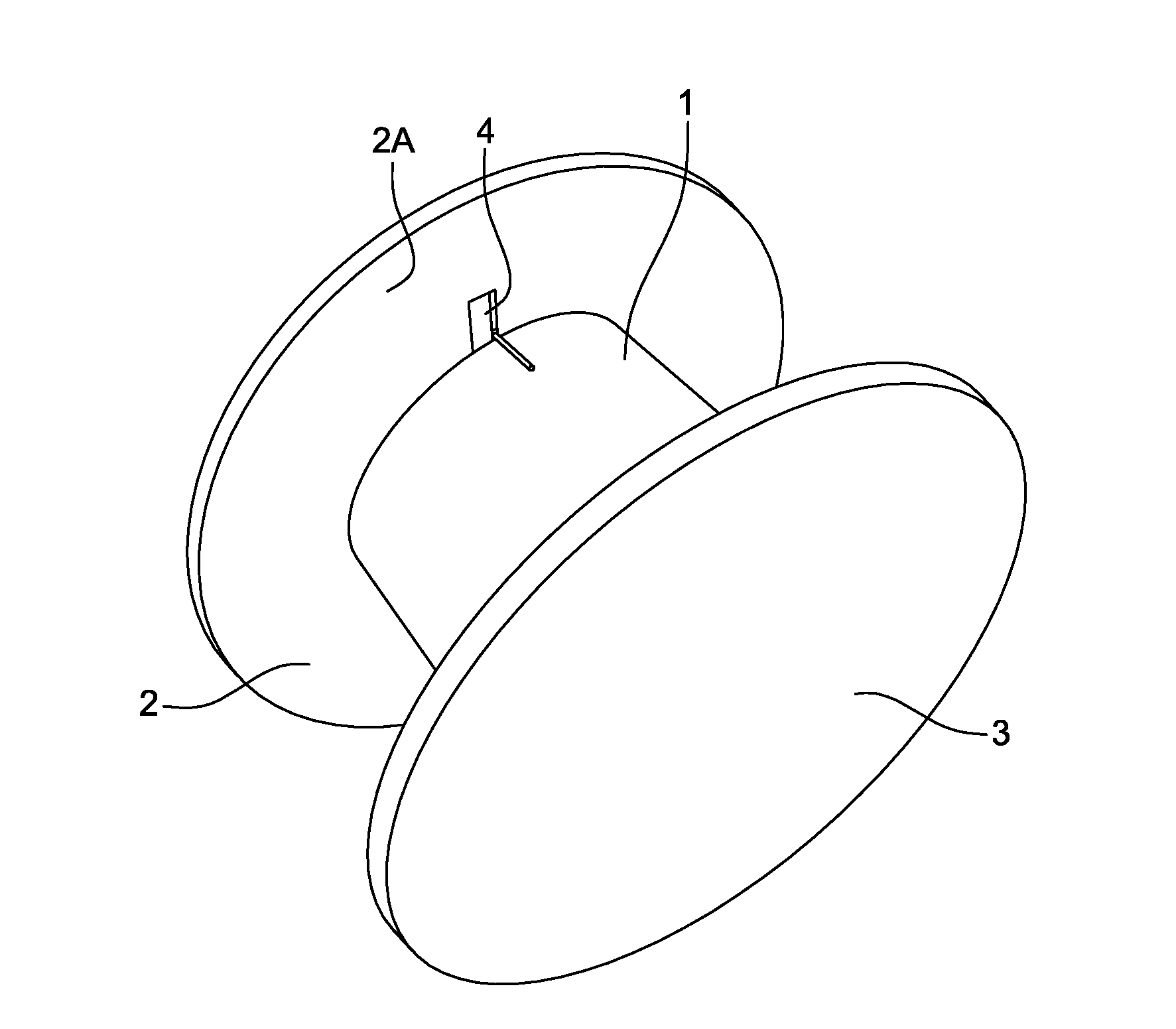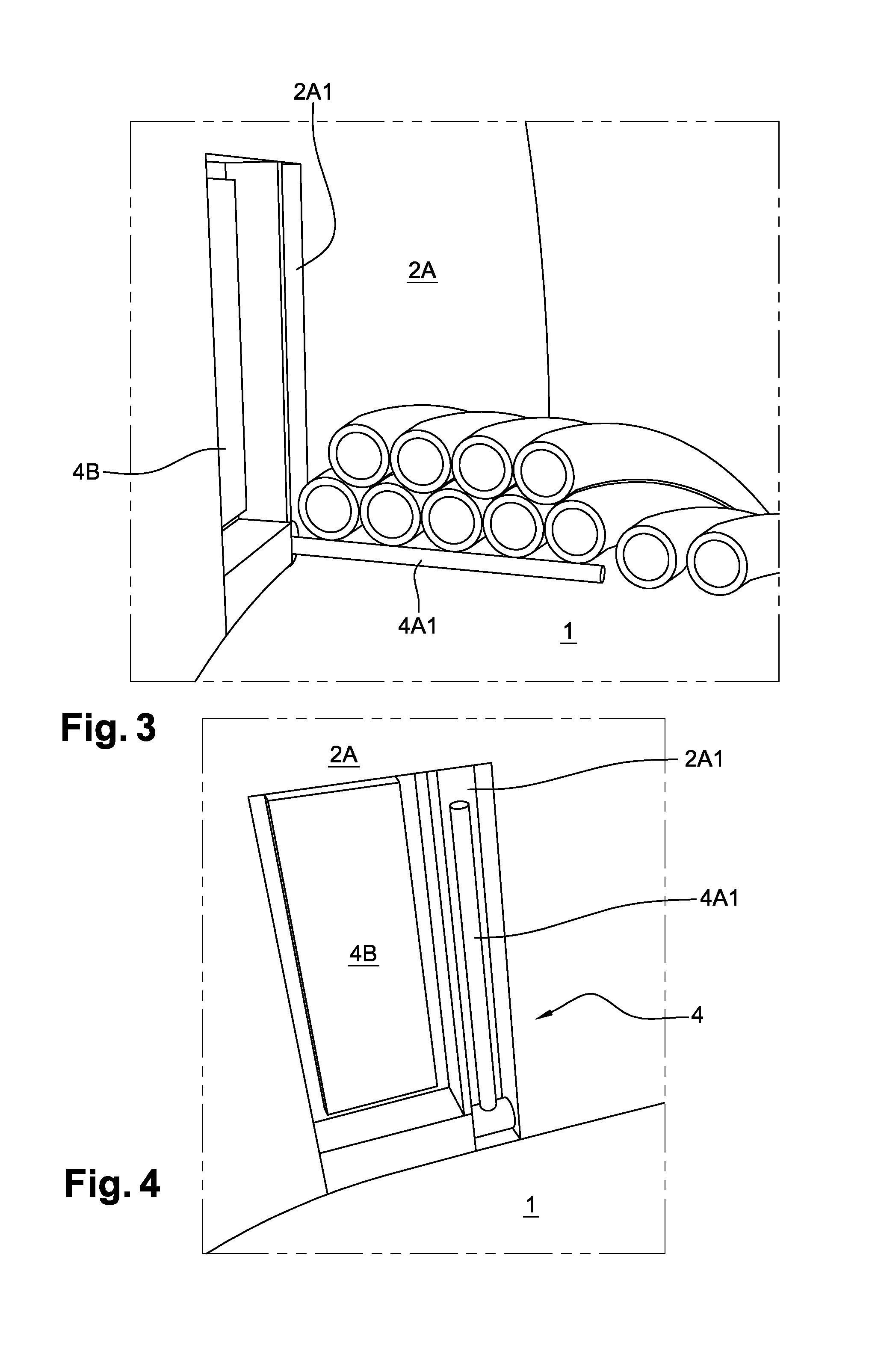Electric Cable Reel
POULIN; Nicolas ; et al.
U.S. patent application number 16/347301 was filed with the patent office on 2019-09-19 for electric cable reel. The applicant listed for this patent is NEXANS. Invention is credited to Olivier PINTO, Nicolas POULIN.
| Application Number | 20190284016 16/347301 |
| Document ID | / |
| Family ID | 57861057 |
| Filed Date | 2019-09-19 |



| United States Patent Application | 20190284016 |
| Kind Code | A1 |
| POULIN; Nicolas ; et al. | September 19, 2019 |
ELECTRIC CABLE REEL
Abstract
The invention relates to an electrical cable reel. According to the invention, the reel comprises an arrangement (4) for remotely monitoring the absence of cable wound around the reel, said arrangement comprising a sensor (4A) and an electronic board connected to the sensor and linked to a remote application that is enabled.
| Inventors: | POULIN; Nicolas; (Auchy les Mines, FR) ; PINTO; Olivier; (Francheville, FR) | ||||||||||
| Applicant: |
|
||||||||||
|---|---|---|---|---|---|---|---|---|---|---|---|
| Family ID: | 57861057 | ||||||||||
| Appl. No.: | 16/347301 | ||||||||||
| Filed: | October 26, 2017 | ||||||||||
| PCT Filed: | October 26, 2017 | ||||||||||
| PCT NO: | PCT/FR2017/052951 | ||||||||||
| 371 Date: | May 3, 2019 |
| Current U.S. Class: | 1/1 |
| Current CPC Class: | B65H 75/44 20130101; B65H 2701/34 20130101; B65H 75/4484 20130101 |
| International Class: | B65H 75/44 20060101 B65H075/44 |
Foreign Application Data
| Date | Code | Application Number |
|---|---|---|
| Nov 9, 2016 | FR | 1660820 |
Claims
1. An electric cable reel, comprising: an arrangement for remote monitoring of the absence of cable wound on the reel, having a sensor; and an electronic board connected to said sensor and linked to an active remote application.
2. The reel as claimed in claim 1, wherein said monitoring arrangement is incorporated into a flange of the reel.
3. The reel as claimed in claim 2, wherein said monitoring arrangement is incorporated into the inner face of said flange.
4. The reel as claimed in claim 3, wherein said sensor is an electromechanical end-of-travel sensor which is disposed at the edge of the drum and a rod of which is urged by a return force into a slot arranged in the inner face of said flange.
5. The reel as claimed in claim 1, wherein said reel is also equipped with a geolocation arrangement.
6. The reel as claimed in claim 4, wherein said rod is disposed perpendicularly to said inner face of the reel, against the surface of the drum, when the electric cable is wound on the reel, this cable covering said rod.
7. A method for monitoring a reel as claimed in claim 4, wherein an alert is transmitted by said electronic board to said remote application when said rod is returned into said slot.
Description
[0001] The invention relates to a reel for an electric cable.
[0002] Currently, no reel for an electric cable allows automatic monitoring of the presence or absence of cable wound on the reel.
[0003] However, it may be very useful for the user or owner of the reel to check the presence of available electric cable in order, among other things, to place an order quickly when the stock thereof runs out.
[0004] The invention solves this problem.
[0005] More specifically, the invention proposes a reel for an electric cable, characterized in that it has an arrangement for remote monitoring of the absence of cable wound on the reel, having a sensor and an electronic board connected to said sensor and linked to an active remote application.
[0006] According to one preferred embodiment, said monitoring arrangement is incorporated into a flange of the reel.
[0007] Preferably, said monitoring arrangement is incorporated into the inner face of said flange.
[0008] Advantageously, said sensor is an electromechanical end-of-travel sensor which is disposed at the edge of the drum and a rod of which is urged by a return force into a slot arranged in the inner face of said flange.
[0009] This type of mechanical sensor is particularly reliable and inexpensive.
[0010] Advantageously, the reel is also equipped with a geolocation arrangement.
[0011] The invention also relates to the use of such a reel, characterized in that said rod is disposed perpendicularly to said inner face of the reel, against the surface of the drum, when the electric cable is wound on the reel, this cable covering said rod.
[0012] Finally, the invention relates to a method for monitoring such a reel, characterized in that an alert is transmitted by said electronic board to said remote application when said rod is returned into said slot.
[0013] The invention is described in more detail below with the aid of figures that show only a preferred embodiment of the invention.
[0014] FIG. 1 is a perspective view of a reel according to the invention.
[0015] FIG. 2 is a detail view of a reel according to the invention before a cable has been wound thereon.
[0016] FIG. 3 is a sectional detail view of a reel according to the invention after a cable has been wound thereon.
[0017] FIG. 4 is a perspective detail view of a reel according to the invention after the cable has been completely unwound.
[0018] As shown in the figures, a reel for an electric cable conventionally has a drum 1 about which a cable is intended to be wound, and two lateral flanges 2, 3.
[0019] According to the invention, it has an arrangement 4 for remote monitoring of the absence of cable wound on the reel, having a sensor 4A and a battery powered electronic board connected to the sensor and linked to an active remote application. This electronic board is contained in a housing 4B adjacent to the sensor 4A and comprises an arrangement for monitoring the state of the battery.
[0020] This monitoring arrangement 4 is incorporated in a flange 2 of the reel, and more specifically in the inner face 2A of this flange.
[0021] The sensor 4A is an electromechanical end-of-travel sensor which is disposed at the edge of the drum 1 and a rod 4A1 of which, having a rotary joint at one of its ends, is urged by a return force into a slot 2A1 arranged in the inner face 2A of the flange.
[0022] By way of example, this sensor may be an "RS Pro, NO/NF, 10A, 400V, IP65" electromechanical end-of-travel sensor sold by the company RS.
[0023] FIGS. 1 and 2 show the reel before a cable has been wound on the drum 1.
[0024] The rod 4A1 is then disposed perpendicularly to the inner face 2A of the reel, against the surface of the drum 1.
[0025] When the electric cable is wound on the drum 1, as shown in FIG. 3, this cable covers the rod 4A1 and retains it in this position counter to the return force.
[0026] When all of the cable has been unwound from the drum, as shown in FIG. 4, the rod 4A1 is released and, urged by the return force, is returned into the slot 2A1. In this position, an alert is transmitted by the electronic board to the remote application.
[0027] This remote application is preferably an application connected to a mobile network, in particular GSM (acronym for "Global System for Mobile Communications") or SIGFOX.
[0028] To allow the management of a set of such reels, each reel advantageously has an electronic identification number.
[0029] Each reel may have a geolocation arrangement in order to provide a user who needs a particular length of cable with the reference and the position of reels that can supply said user with the cable.
* * * * *
D00000

D00001

D00002

XML
uspto.report is an independent third-party trademark research tool that is not affiliated, endorsed, or sponsored by the United States Patent and Trademark Office (USPTO) or any other governmental organization. The information provided by uspto.report is based on publicly available data at the time of writing and is intended for informational purposes only.
While we strive to provide accurate and up-to-date information, we do not guarantee the accuracy, completeness, reliability, or suitability of the information displayed on this site. The use of this site is at your own risk. Any reliance you place on such information is therefore strictly at your own risk.
All official trademark data, including owner information, should be verified by visiting the official USPTO website at www.uspto.gov. This site is not intended to replace professional legal advice and should not be used as a substitute for consulting with a legal professional who is knowledgeable about trademark law.